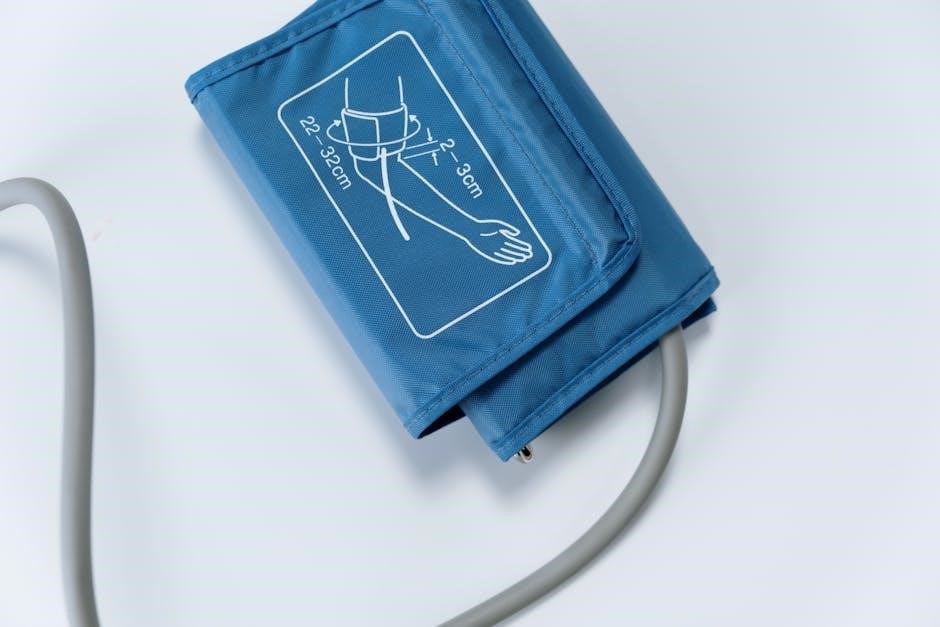Smart heart blood pressure monitors represent a significant evolution in health monitoring‚ combining accuracy with modern technology for convenient‚ real-time tracking. These devices integrate seamlessly with wearables‚ offering detailed insights and enhancing overall well-being through advanced data management.
Overview of Smart Blood Pressure Monitoring Technology
Smart blood pressure monitoring technology combines innovative sensors and algorithms to provide accurate‚ real-time health insights. Devices like smartwatches and wearable rings use methods such as Pulse Transit Time (PTT) to measure blood pressure continuously without inflation. These technologies integrate seamlessly with smartphones and health apps‚ offering detailed reports and trend analysis. They enable early detection of hypertension and other cardiovascular conditions‚ promoting timely interventions. With their compact designs and user-friendly interfaces‚ smart monitors make regular blood pressure tracking effortless‚ empowering users to manage their health proactively and maintain better cardiovascular well-being.
Importance of Accurate Blood Pressure Monitoring
Accurate blood pressure monitoring is crucial for early detection of hypertension‚ preventing complications like heart disease and stroke. Inconsistent or incorrect readings can lead to misdiagnosis or inappropriate treatment. Smart heart monitors ensure precise measurements‚ enabling individuals to track trends and make informed decisions. With features like continuous tracking and AI insights‚ these devices empower users to manage their health proactively. Regular monitoring helps identify patterns‚ allowing for timely medical interventions. As seen with devices like the Withings BPM Vision‚ accurate data is key to effective hypertension management and overall well-being.
Key Features of Smart Heart Blood Pressure Monitors
These devices offer real-time blood pressure and heart rate tracking‚ wireless data syncing‚ customizable alerts‚ and advanced data analysis for personalized health insights and better monitoring.
Real-Time Blood Pressure and Heart Rate Tracking
Smart heart blood pressure monitors provide instantaneous readings‚ enabling users to track their blood pressure and heart rate continuously. By utilizing advanced sensors‚ these devices deliver accurate‚ real-time data‚ empowering individuals to monitor their cardiovascular health proactively. The integration of cutting-edge technology‚ such as pulse transit time (PTT) measurement‚ allows for non-invasive and seamless tracking without the need for traditional cuff inflation. This feature is particularly beneficial for individuals who require frequent monitoring‚ as it offers immediate insights into their health status‚ helping them make informed decisions to maintain wellness.
Wireless Connectivity and Data Syncing
Wireless connectivity is a cornerstone of smart heart blood pressure monitors‚ enabling seamless data syncing to smartphones‚ tablets‚ or wearables via Bluetooth or Wi-Fi. This feature allows users to store readings in companion apps‚ track trends‚ and share data with healthcare providers. Automatic syncing ensures that every measurement is saved and organized‚ eliminating manual logging. Compatibility with popular platforms like Apple Health and Google Fit enhances integration‚ while cloud storage provides accessibility across devices. Customizable alerts notify users when readings deviate from normal ranges‚ promoting timely interventions and better health outcomes.
Customizable Alerts and Reminders
Smart heart blood pressure monitors offer customizable alerts and reminders to ensure consistent monitoring and proactive health management. Users can set specific blood pressure thresholds‚ receiving notifications when readings fall outside normal ranges. Reminders can be scheduled for regular measurements‚ helping users maintain a routine. Additionally‚ some devices integrate with mobile apps‚ enabling personalized alerts for medication times or follow-up appointments. These features enhance adherence to treatment plans and provide peace of mind‚ ensuring users stay informed and empowered to manage their health effectively. Customizable settings allow for tailored alerts‚ making monitoring seamless and user-friendly.
Advanced Data Analysis and Reporting
Smart heart blood pressure monitors offer sophisticated data analysis‚ providing users with actionable insights into their cardiovascular health. By leveraging AI‚ these devices can detect patterns‚ predict potential risks‚ and offer personalized recommendations. Advanced reporting features enable users to track blood pressure trends over time‚ while detailed graphs and charts make it easier to understand fluctuations. Integration with health apps allows for a holistic view of wellness metrics‚ empowering users to make informed lifestyle changes. Customizable reports and alerts ensure users stay proactive about their health‚ fostering early detection and management of hypertension.
How to Choose the Right Smart Blood Pressure Monitor
Selecting the ideal smart blood pressure monitor involves evaluating accuracy‚ compatibility with your devices‚ and ease of use. Consider features like EKG‚ heart rate monitoring‚ and app integration for enhanced functionality. Ensure the device meets clinical standards and fits your lifestyle needs.
Factors to Consider: Accuracy‚ Compatibility‚ and Ease of Use
When selecting a smart heart blood pressure monitor‚ prioritize accuracy to ensure reliable readings. Look for devices certified by reputable organizations. Compatibility with your smartphone or wearable devices is essential for seamless data syncing. Opt for monitors that support both iOS and Android. Ease of use is crucial; choose a device with an intuitive interface‚ such as a touchscreen or voice guidance. Additional features like automated logging and silent inflation enhance user experience. Ensure the monitor fits your lifestyle and health needs‚ offering a balance of functionality and simplicity for daily use.
Popular Brands and Their Unique Features
Leading brands like Withings‚ Omron‚ and Xiaomi offer innovative smart blood pressure monitors. Withings’ BPM Vision combines a smart cuff with a companion app for seamless connectivity. Omron‚ a trusted name in healthcare‚ provides high-accuracy monitors with intuitive interfaces. Xiaomi’s MIJIA Smart Electronic Blood Pressure Monitor is known for its affordability and large LCD display. Additionally‚ brands like Aktiia introduce continuous monitoring via wearable bracelets‚ while others integrate with smartwatches for holistic health tracking. Each brand brings unique features‚ catering to diverse user needs and preferences‚ ensuring accurate and convenient blood pressure management.

Setting Up Your Smart Heart Blood Pressure Monitor
Setting up your smart heart blood pressure monitor involves unboxing‚ registering the device‚ and pairing it with your smartphone or watch for seamless connectivity and calibration.
Unboxing and Initial Registration
When you unbox your smart heart blood pressure monitor‚ you’ll typically find the device‚ a cuff‚ a power adapter‚ and a quick-start guide. Before first use‚ download the companion app and create an account to register your device. Follow in-app instructions to pair the monitor with your smartphone via Bluetooth or Wi-Fi. Ensure the device is fully charged and updated with the latest firmware. Registration allows for personalized settings‚ data syncing‚ and access to advanced features. This step is crucial for ensuring accurate readings‚ secure data storage‚ and optimal performance tailored to your health needs.
Pairing the Device with Your Smartphone or Watch
Pairing your smart heart blood pressure monitor with a smartphone or smartwatch ensures seamless data syncing. Download the companion app‚ enable Bluetooth‚ and follow in-app instructions to connect the device. Once paired‚ readings automatically sync‚ providing real-time tracking and alerts. Ensure your device is compatible with your smartphone’s operating system or wearable. Many monitors integrate with popular platforms like Apple Health or Google Fit‚ enhancing your holistic health monitoring experience. This connectivity allows for instant feedback and long-term tracking‚ making managing your blood pressure effortless and efficient.
Calibrating the Monitor for Accurate Readings
Calibrating your smart heart blood pressure monitor ensures precise measurements. Start by placing the cuff correctly on your arm and using a reference device like a traditional monitor. Follow the manufacturer’s instructions to sync the readings‚ typically involving a series of test measurements. Ensure the environment is stable‚ avoiding movement or stress. Calibration is usually required during initial setup and periodically every 3-6 months. Some devices automatically calibrate via paired wearables or apps‚ enhancing convenience. Accurate calibration is essential for reliable data‚ ensuring your monitor delivers trustworthy results for better health management.

Using Your Smart Blood Pressure Monitor
Using your smart blood pressure monitor involves simple steps for real-time tracking. Ensure proper cuff placement‚ remain still‚ and follow on-screen instructions for accurate readings. Integrated with wearables‚ these devices provide instant heart rate and BP data‚ offering a seamless health monitoring experience.
Step-by-Step Guide to Taking Measurements
To take accurate measurements‚ sit comfortably with your back straight and feet flat on the floor. Ensure the cuff is at heart level and properly secured around your upper arm. Avoid tight clothing that may restrict blood flow. Turn on the monitor and follow on-screen instructions. Remain still and silent during the measurement to ensure precise readings. Once complete‚ the device will display your systolic‚ diastolic‚ and heart rate. Check the results on the OLED screen or synced app. For inconsistent readings‚ retake the measurement after a short break. Always log your results for tracking and future reference.
Understanding the OLED Display and Readouts
The OLED display on smart heart blood pressure monitors provides clear‚ high-contrast readouts of systolic and diastolic blood pressure‚ heart rate‚ and pulse waveforms. Some models also show heart rate variability (HRV) and irregular heartbeat detections. The screen is typically backlit for easy viewing in low-light conditions. Readouts are displayed in large‚ easy-to-read fonts‚ with color-coded indicators for normal‚ elevated‚ or high blood pressure levels. Additional symbols may denote battery status‚ Bluetooth connectivity‚ or alarm notifications. The intuitive interface ensures users can quickly interpret their data‚ making it simpler to track trends and manage their cardiovascular health effectively.

Maintaining Your Smart Blood Pressure Monitor
Regularly clean the device with a soft cloth and store it in a dry place to maintain accuracy. Update software periodically for optimal performance and connectivity.
Cleaning and Storing the Device
To maintain your smart heart blood pressure monitor’s performance‚ gently clean it with a soft‚ dry cloth. Avoid harsh chemicals or excessive moisture‚ as they may damage the sensors or screen. For the cuff‚ wipe it with a slightly damp cloth and let it air dry. Store the device in a cool‚ dry place‚ away from direct sunlight‚ to prevent overheating. Use the provided case or pouch to protect it from dust and scratches. Regular cleaning ensures accurate readings‚ while proper storage extends the device’s lifespan and reliability.
Always check for software updates before storing the device for extended periods to ensure optimal functionality when reused.
Updating Software and Firmware
Regular software and firmware updates are essential to ensure your smart heart blood pressure monitor performs optimally. These updates often improve accuracy‚ add new features‚ and enhance security. To update‚ connect your device to the companion app via Bluetooth or Wi-Fi‚ then follow in-app prompts to download and install the latest version. Some devices automatically check for updates‚ while others may require manual checks. Always ensure a stable internet connection and sufficient battery life before proceeding. Refer to your device’s manual for specific instructions‚ as processes may vary by brand. Keeping your monitor updated guarantees the best performance and data reliability.

Troubleshooting Common Issues
Common issues include connectivity problems‚ inaccurate readings‚ or synchronization errors. Restarting the device‚ re-pairing with wearables‚ or recalibrating often resolves these issues effectively.
Resolving Connectivity Problems
Connectivity issues with your smart heart blood pressure monitor can be frustrating but are often easy to resolve. First‚ ensure your device and smartphone have Bluetooth enabled and are within range. Restart both devices to refresh the connection. Check for software updates‚ as outdated firmware or apps may cause compatibility issues. If problems persist‚ reset the monitor by following the manufacturer’s instructions‚ typically found in the manual. Clearing the app cache or reinstalling the app can also resolve connectivity glitches. If none of these steps work‚ contact customer support for further assistance or troubleshooting.
Addressing Inaccurate Readings
Inaccurate readings on a smart heart blood pressure monitor can occur due to improper cuff placement‚ movement during measurement‚ or incorrect cuff sizing. To resolve this‚ ensure the cuff is snug and positioned correctly on your bare arm. Avoid moving or talking during measurements‚ as this can disrupt accuracy. If issues persist‚ recalibrate the device according to the user manual or restart it. Regular software updates also help maintain precision. For persistent inaccuracies‚ consult a healthcare professional to verify results and adjust settings if needed.

Advanced Features and Integration
Smart heart monitors integrate seamlessly with smartwatches and health apps‚ offering advanced features like continuous blood pressure tracking via PTT technology‚ providing users with comprehensive health insights and personalized recommendations effortlessly.
Smartwatch and Wearable Device Compatibility
Smart heart blood pressure monitors seamlessly integrate with smartwatches and wearables‚ enhancing health tracking. Devices like the Circulars Ring 2 use Pulse Transit Time (PTT) for blood pressure trends‚ syncing data to wearables. Withings BPM Vision connects to compatible devices‚ offering a unified health dashboard. Xiaomi’s MIJIA monitor pairs with wearables‚ providing real-time heart rate and BP insights. This integration allows users to receive alerts‚ track trends‚ and manage health effortlessly‚ empowering proactive well-being through connected technology.
Integration with Health and Fitness Apps
Smart heart blood pressure monitors seamlessly integrate with popular health and fitness apps‚ enabling users to sync their blood pressure and heart rate data effortlessly. This integration allows for a comprehensive health profile‚ combining data from wearables‚ calorie trackers‚ and other wellness tools. Apps like Withings Health Mate or Xiaomi’s Mi Home platform provide detailed analytics‚ enabling users to track trends and receive personalized insights. This connectivity also supports early detection of potential issues‚ fostering proactive health management and enhancing overall well-being through a unified digital health ecosystem.
Real-World Applications and Benefits
Smart heart blood pressure monitors enable users to track trends‚ detect early warnings‚ and manage hypertension effectively‚ promoting better health outcomes and lifestyle adjustments for long-term well-being.
Monitoring Blood Pressure Trends Over Time
Tracking blood pressure trends over time is crucial for understanding cardiovascular health and making informed lifestyle adjustments. Smart heart monitors enable users to capture consistent readings‚ identifying patterns and potential issues early. By analyzing historical data‚ individuals can observe how factors like diet‚ exercise‚ and stress impact their blood pressure. This longitudinal insight supports better decision-making and encourages proactive health management. Advanced devices‚ such as the Circulars Ring 2‚ even use Pulse Transit Time (PTT) to continuously monitor trends without inflation‚ providing seamless‚ real-time tracking. Regular monitoring also helps users stay motivated to maintain healthier habits and share detailed reports with healthcare providers for personalized care.
Case Studies: How Users Benefit from Smart Monitors
Real-world users have experienced significant benefits from smart heart blood pressure monitors. For instance‚ a man named Kaan developed a smart ring to monitor blood pressure after his father suffered a heart attack. This device measures Pulse Transit Time (PTT)‚ providing continuous tracking without bulky cuffs. Another user‚ leveraging the Withings BPM Vision‚ found it simplified monitoring and integration with wearables. These case studies highlight how smart monitors empower individuals to manage hypertension proactively‚ offering convenience‚ accuracy‚ and peace of mind through real-time insights and seamless connectivity.
Future of Smart Blood Pressure Monitoring
Emerging technologies promise continuous‚ non-invasive monitoring and AI-driven insights‚ enabling proactive health management through wearable devices like smart rings and watches‚ revolutionizing blood pressure tracking.
Emerging Technologies: Continuous Monitoring and AI Insights
Emerging technologies like continuous blood pressure monitoring and AI-driven insights are revolutionizing health care. Devices such as the Circulars Ring 2 and Aktiia bracelet enable real-time tracking without bulky cuffs‚ using methods like Pulse Transit Time (PTT). AI algorithms analyze data to detect trends‚ predict potential issues‚ and offer personalized recommendations. These innovations‚ integrated with smartwatches and apps‚ empower users to manage their health proactively. The Withings BPM Vision and Xiaomi MIJIA monitor further enhance this with seamless app integration‚ making blood pressure monitoring smarter and more accessible than ever before.
Smart heart blood pressure monitors empower users to effectively manage their blood pressure and heart health through precise insights‚ promoting a proactive approach to wellness and long-term health.
Best Practices for Using Your Smart Heart Blood Pressure Monitor
To ensure accurate and reliable readings‚ always calibrate your monitor as instructed and use it in a quiet‚ relaxed environment. Position the cuff correctly on your bare arm at heart level. Avoid eating‚ exercising‚ or consuming caffeine 30 minutes before measurement. Take readings at consistent times daily to track trends effectively. Follow the manufacturer’s guidelines for cuff size and placement. Stay still and silent during measurements to prevent errors. Regularly update the device’s software and apps for optimal performance. Consult your healthcare provider for interpreting results and adjusting lifestyles based on data insights.


